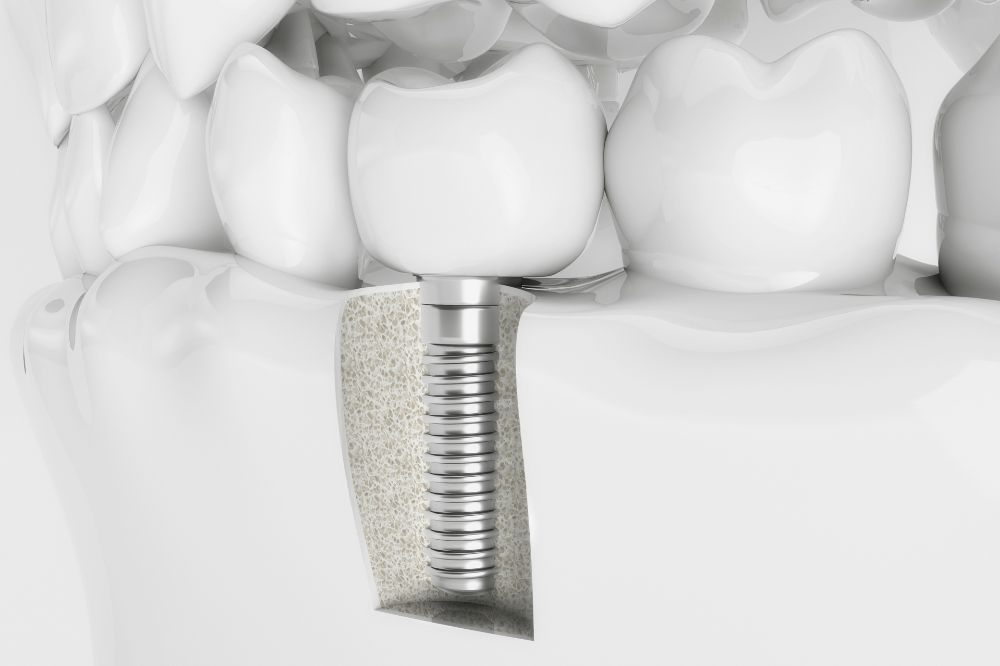If you’ve lost a tooth or need to have one extracted, you’ll probably be thinking about your options for filling the gap – because not only can a gap make you feel self-conscious about your smile, but it can also affect the way you eat and the types of food you can chew.
One of the possibilities you may be considering is having dental implants fitted. However, these are notoriously expensive if you have to pay for them yourself – so to help, in this post, we have all the info you need about how to get dental implants covered by insurance.
How to Get Dental Implants Covered by Insurance
What is a dental implant?
Before we talk about getting dental implants covered by insurance, let’s take a step back and talk about what dental implants are – because that will help us understand a bit more about the insurance issues related to undergoing this procedure.
Dental implants are a long-term solution designed to fill gaps created by tooth loss by replacing the missing tooth with an artificial one – along with the tooth root beneath the gum.
They consist of a small titanium screw that is inserted into the jawbone, which then fuses with the jaw, holding it firmly in place.
The procedure involves removing the old tooth if necessary, after which the screw – known as the “post” – is attached to the jaw.
The post is then left to fuse with the jaw for between three and six months, and then the abutment (the connector) is attached to the post – and the crown is then attached to the abutment.
There are many advantages to having tooth implants. Once fitted, the implant looks just like a natural tooth. The implant restores comfort to the mouth that may have been caused by the gap, and it can also be used for chewing food, just like a natural tooth.
The implant can also help prevent bone loss in the jaw – and in some cases, can even reverse it.
As well as all the practical considerations, dental implants are also a popular option since they fill in visible gaps left by missing teeth, something that many people feel gives them more confidence to smile again without feeling self-conscious about their gappy mouth.
However, this is also part of the reason why some insurance companies don’t cover dental implants – as we’ll see in just a moment.
If you want to learn more about the procedure for having dental implants fitted, you can also watch this video before reading on.
Why is it not covered by some insurance plans?
Although having missing teeth replaced is essential for people’s confidence, well-being and even their ability to eat normally, unfortunately, some insurance companies see this kind of procedure merely as cosmetic and won’t cover it.
However, this can vary significantly from one insurance provider to another, so the first thing you need to do is find out whether your policy covers the procedure or even covers part of it.
Sometimes, whether an insurance company will cover the implants can also be affected by the specific circumstances of why you need the implants or how you lost the tooth, so again, this is something you’ll need to check in your policy.
For example, dental implants after oral cancer may be covered by some policies.
Which parts of the procedure are covered?
Although many insurance companies consider dental implants a cosmetic procedure and won’t cover it, some parts of the procedure may still be covered. Here is a list of the steps that insurance companies may or may not cover.
- Tooth extraction
If you need to have a bad tooth pulled out before having it replaced by an implant, this part of the procedure is usually covered by most dental insurance policies, either in full or in part.
- Bone grafting
Not all patients are suitable for dental implants, and some will need to have their jaws reinforced before the implants can be fitted. This part is usually not covered by most insurance policies.
- Placing the implant
In insurance terms, this step is considered a “major” procedure, and some insurance policies will cover 50% of major procedures.
- Placing the artificial tooth
This is also considered a “major” procedure, but some insurance companies will cover more than 50% of this step since it is considered the same as placing a crown on a tooth to stop decay.
How to get your insurance to cover your treatment
Here are the steps you should go through to get your insurance to cover your dental implants.
Step 1. Read your policy carefully
The first thing to do if you’re thinking about getting dental implants is to read through your policy carefully to check for any details about this procedure.
If dental implants are mentioned specifically, you may be able to work out whether your policy covers the whole procedure, just part of it or none of it.
You may also find details of the circumstances in which having dental implants fitted may or may not be covered.
Step 2. Contact your insurance company directly
Even if your policy contains specific details about dental implants, the next step should still be to contact your insurance company to ask them questions about having the procedure done.
The questions you’ll need to ask them include:
- Is the procedure covered?
- Is the whole procedure covered or just part of it?
- Are there specific circumstances where implants are/aren’t covered?
- What percentage of the costs does the policy cover?
- What is the annual limit to the amount the policy will cover?
- Do you need a referral before beginning the procedure?
Once you have the answers to questions like these, you can then decide whether it’s feasible for you to go ahead with the procedure.
Step 3. Work out your budget and find a dentist to do the procedure
Having done your research about whether dental implants are covered – or which parts are covered – you can then work out if you have the budget to have implants fitted.
You will need to find out how much your insurance will pay and how much you will have to cover yourself to work out if the procedure is something you want to do.
Tips for getting insurance to cover the procedure
Even though you may find your insurance policy doesn’t cover any or all of having dental implants fitted, there are still a few things you can do to reduce the costs you’ll have to pay yourself. Here are a few tips you can try.
1. Have the procedure done over two years
Since many insurance policies have a maximum amount they will cover each year, you can increase the amount your company pays by having the procedure done over two separate years.
For example, you can have the first part of the procedure done at the end of one year and then have the next part done at the start of the following year, allowing you to claim for each step as part of your allowance for different years.
2. Use your insurance for the parts that are covered
Even if the actual implant is not covered by your insurance, other parts of the procedure may be covered – so try to claim for as much as you can.
For example, while having the implanted tooth is not often covered by most standard insurance policies, some of the other parts of the procedure may be covered – so again, check your policy carefully for the details.
3. Get the dentist involved
Dental implants are expensive – having a single tooth replaced can cost around $5,000. As a result, many dentists offer a service helping you deal with the insurance company since this is something they have plenty of experience with.
As a result, they may be able to advise you and help you deal with the insurance side of things to help you obtain a better outcome.
4. Look for insurance policies that cover dental implants
If you think you might need a dental implant in the coming years, shop around and look for an insurance policy that will cover it.
Most insurance policies that offer such cover have a “waiting period”, meaning you have to wait a certain amount of time after taking out the policy before you are entitled to such major treatments.
However, if you are not in a rush to get the work done and can wait for a year or two, this could be the best option.
5. Check your medical insurance too
You may be able to claim some of the costs for dental implants on your medical insurance too. For this reason, it’s worth checking that policy because you may be able to use a combination of medical insurance and dental insurance to pay for your dental implants.
Plenty of things you can do to get implants covered
As we’ve seen, most dental insurance policies don’t cover dental implants since they’re considered cosmetic rather than essential – however misguided and unfair this may seem.
However, even if your policy doesn’t cover the whole procedure, there are still a few things you can do to maximize how much your insurance will cover – which may allow you to consider having the procedure done, even if it would otherwise be too expensive.

